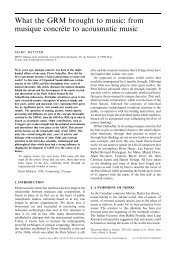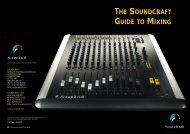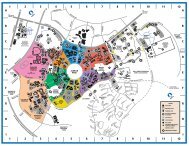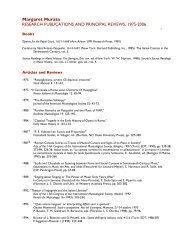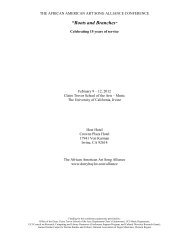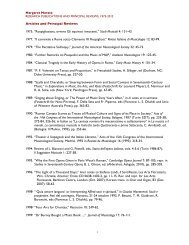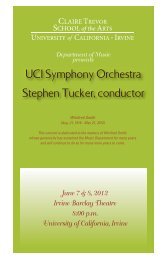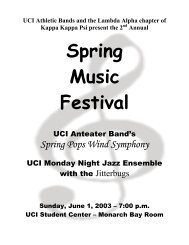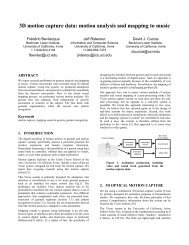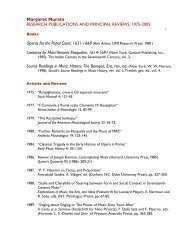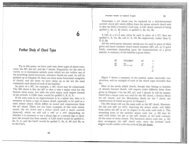amy bauer The Other of the Exotic: Balinese Music as Grammatical ...
amy bauer The Other of the Exotic: Balinese Music as Grammatical ...
amy bauer The Other of the Exotic: Balinese Music as Grammatical ...
Create successful ePaper yourself
Turn your PDF publications into a flip-book with our unique Google optimized e-Paper software.
<strong>The</strong> <strong>O<strong>the</strong>r</strong> <strong>of</strong> <strong>the</strong> <strong>Exotic</strong> 353<br />
from a <strong>the</strong>matic statement at one pitch level to contrapuntal development in a<br />
new octave (bars 10, 22, 24–27, 37, 40–41 and 44–45). <strong>The</strong> steady expansion<br />
and contraction <strong>of</strong> rhythmic groups by complex ratios effaces any sense <strong>of</strong><br />
periodic recurrence and shifts <strong>the</strong> formal emph<strong>as</strong>is from pitch and rhythm to<br />
articulation, register and dynamic contr<strong>as</strong>t. For instance, in <strong>the</strong> midst <strong>of</strong> bar 19<br />
<strong>the</strong> right hand begins a series <strong>of</strong> 7 semiquaver attacks against an alternating 5 + 4<br />
pattern in <strong>the</strong> left hand.Thus, three groups <strong>of</strong> 7 coincide with <strong>the</strong> cycle 5–4–5 in<br />
bar 20. Were this pattern to continue, both cycles would meet again on <strong>the</strong><br />
downbeat <strong>of</strong> bar 24. But Ligeti interrupts <strong>the</strong> 7 cycle with <strong>the</strong> pattern 3–3–3–4<br />
(bars 21–22).<strong>The</strong> effect <strong>of</strong> this interpolated ‘short cycle’ is a perceived acceleration<br />
<strong>of</strong> <strong>the</strong> tempo, despite its firm grounding in <strong>the</strong> semiquaver pulse.<br />
<strong>The</strong> metric confusion caused by accent patterns that are uneven or whose<br />
durations are prime numbers creates a static, hovering effect augmented by <strong>the</strong><br />
rotating embellishment groups (bars 22–23), <strong>the</strong> wedge-like expansion <strong>of</strong> <strong>the</strong><br />
ambitus from three to seven octaves and <strong>the</strong> rapid, seven-bar crescendo from<br />
pianississimo to fortississimo (bars 19–26). A schematic outline <strong>of</strong> <strong>the</strong> form in<br />
Ex. 10 correlates <strong>the</strong> general expansion and contraction <strong>of</strong> range throughout <strong>the</strong><br />
work with its dynamic and sectional divisions. 25<br />
<strong>The</strong> Virtuoso Étude <strong>as</strong> kre<strong>as</strong>i baru<br />
‘Galamb borong’ thus captures <strong>the</strong> spirit <strong>of</strong> gamelan kebyar (kebyar meaning ‘to<br />
flare up suddenly or to burst open’) and its contemporary manifestation in <strong>the</strong><br />
rhapsodic composition <strong>of</strong> kre<strong>as</strong>i baru, or new creations. In <strong>the</strong>se, <strong>the</strong> transitions<br />
between sections are <strong>of</strong>ten abrupt or ametric, and <strong>the</strong> composition <strong>as</strong> a whole is<br />
marked by shifts in cycle and texture over a rapid and flexible underlying pulse. 26<br />
Octave support for <strong>the</strong> core melody begins in bar 10 <strong>of</strong> <strong>the</strong> Étude. <strong>The</strong> first<br />
unab<strong>as</strong>hedly independent melodic statement sounds <strong>as</strong> a brief tenuto melody in<br />
<strong>the</strong> middle register <strong>of</strong> bars 27–32, underpinned by a series <strong>of</strong> gong-like strokes in<br />
<strong>the</strong> intervals <strong>of</strong> ninth-tenth–ninth. <strong>The</strong> complex partials produced by <strong>the</strong>se<br />
chords recall <strong>the</strong> low frequencies <strong>of</strong> large gongs and drums, which may be tuned<br />
to pitches outside <strong>the</strong> gamelan’s scale. 27<br />
<strong>The</strong> descent to <strong>the</strong> first octave in <strong>the</strong> left hand occurs <strong>as</strong> <strong>the</strong> right hand <strong>as</strong>cends<br />
to <strong>the</strong> eighth octave, and <strong>the</strong> accented melody accrues pitches in <strong>the</strong> interval <strong>of</strong> a<br />
second to form diatonic clusters (bars 26–30).<strong>The</strong> addition <strong>of</strong> a note outside <strong>the</strong><br />
mode in <strong>the</strong> right hand (C8, at <strong>the</strong> upper end <strong>of</strong> <strong>the</strong> keyboard) recalls <strong>the</strong> timbre<br />
<strong>of</strong> reyong kettle gongs, which add invariant notes in <strong>the</strong> middle and upper registers<br />
<strong>of</strong> <strong>the</strong> gamelan.This section in fact resembles reyongan texture, a feature <strong>of</strong> kre<strong>as</strong>i<br />
baru in which <strong>the</strong> high-pitched reyong take over kotekan from <strong>the</strong> gangs<strong>as</strong> for a solo<br />
interlude over <strong>the</strong> colotomic structure. <strong>The</strong> second section <strong>of</strong> <strong>the</strong> Étude culminates<br />
with <strong>the</strong> movement <strong>of</strong> <strong>the</strong> ornamentation into <strong>the</strong> foreground at a fortissimo,<br />
<strong>as</strong> shown in Ex. 11 (bars 32–34), six octaves above a quadruple-forte attack on<br />
C1–G♭1–D2 which is sustained through to <strong>the</strong> end <strong>of</strong> bar 42.<br />
A similar texture occurs at bar 46, where a subito misterioso, molto cantabile<br />
melody enters in right hand, set in rilevo (in relief) over <strong>the</strong> una corda left hand;<br />
<strong>Music</strong> Analysis, 27/ii-iii (2008)<br />
© 2009 <strong>The</strong> Author.<br />
Journal compilation © 2009 Blackwell Publishing Ltd.



